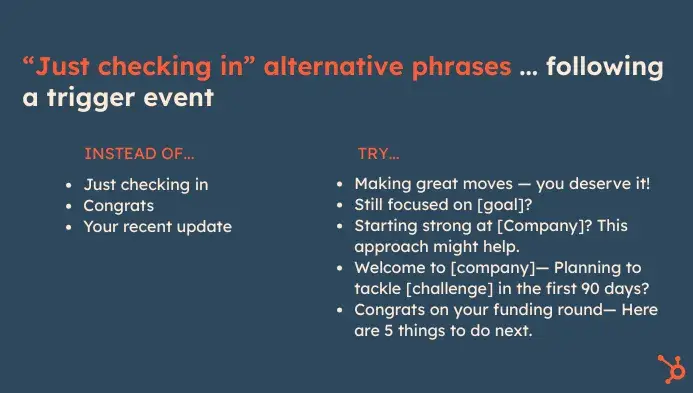22 Alternatives to “Just Checking In”
Have you thought you had a hot lead come in, only to hear crickets after sending your first email? It’s normal — leads need as many as 28 touchpoints before making a purchase.
Lead nurturing, or following up with a prospect by email, plays a key role in getting sales closer to the finish line.
Here are some cold outreach benchmarks from Belkins for context:
- The average cold email reply rate is 5.6%.
- The average reply rate after a follow-up email is 6.9%.
- The optimal waiting time for a follow-up email is 3 days.
- The first follow-up increases reply rates by 49%.
- A second follow-up only increases reply rates by 3.2%.
- Sending three or more follow-ups has a negative effect on reply rates.
But your choice of words is also crucial.
Next time your email goes ignored, try these “just checking in” alternatives to connect with the prospect. In addition to the ideas below, I also recommend checking out this list of 50 proven sales email templates to give you a strong starting point.
Follow-Up Email Templates for Leads Who Ghost You

1. Send them a short piece of actionable advice.
One common mistake I see salespeople making is pointing out a weakness or error a prospective customer has made. For example, “I saw your most recent product launch. Here’s where I think you could improve ....” This is insulting, assumptive, and raises the prospect’s defenses. Instead, try a more relaxed and positive approach.
Template:
Hi [prospect],
You likely deal with [business pain], so I thought I’d share a quick tip many of my clients have found helpful: [1-2 sentence actionable piece of advice].
I have a few more ideas around [improving X]. Let me know if you’re interested in hearing them.
Best,
[Your name]
Here’s the same template after I filled it out for a prospect:
Hi Sofia,
I’m sure that your email open rate is a number you watch closely, so I thought I’d share a quick tip many of my clients have found helpful. HubSpot’s data found that email engagement is the highest between 9 AM and noon, Tuesday and Thursdays. This helped client La Petite Luna increase its opens by 30%.
I have some more data and ideas I can share about boosting email open rates. Let me know if you’re interested in hearing them.
Best,
Jamie
2. Send over a longer how-to guide and offer to follow up in person if they want.
I’ve seen that it takes many touchpoints in a customer journey for them to build trust and warm up to your brand. If they aren’t ready to hop on the phone yet, they might read a piece of content relevant to their role. You’ll educate and help them with one simple email.
Template:
Hi [prospect],
Do you [deal with X/want to improve Y]? Here’s an ebook about [dealing with X/improving Y].
There’s a lot of invaluable advice in there — you might find [specific tip or section] especially helpful. If you’d like to discuss these pointers or anything else around [topic], let’s set up a call.
Best,
[Your name]
Here’s the same template after I filled it out for a prospect:
Hi Jordan,
Would you like your new sales hires to get off the ramp faster? Here’s an ebook about shortening ramp time.
There’s a lot of invaluable advice in here — check out page 30 for an in-depth training cadence. If you’d like to discuss these pointers or anything else around sales hiring and training, let’s set up a call.
Best,
Cara
3. Point to areas for growth.
As we’ve covered, you don’t want to harp on your prospect’s weaknesses. However, I have found that there’s room for gentle suggestions of ways to grow and improve.
Template:
Hi [prospect],
[Company] sounds like it’s doing well — just stumbled across this quote on [Glassdoor/Yelp/Angie’s List/other third-party review site] from one of your [employees/customers]:
[1-2 sentence quote].
[Company] would be even stronger if you [fixed X]. Would you like to follow up about this on a call?
Best,
[Your name]
Here’s the same template after I filled it out for a prospect:
Hi Oleana,
Trusthealth sounds like it’s doing well — I was impressed by this quote on Glassdoor from one of your employees: “This is the best, most supportive office I’ve ever experienced.”
Your company could be even stronger if you offered flexible work policies, which typically increase retention for 89% of companies. Would you like to follow up about this on a call to hear about how this has worked at other companies I work with?
Best,
Kendall
Pro tip: Be sure to write compelling subject lines to get your message opened!
4. Respond to a social post, then follow up with more resources.
You never want to be that salesperson pitching someone in the comments section of a LinkedIn post. Engage with your prospect, yes. Respond to their post with a thoughtful, personalized response. But then, take the conversation offline and follow up with valuable feedback.
Template:
Hey [prospect],
Great post on [social network] about [topic]. Your comment about X was particularly astute — [additional comment].
Here are a couple of resources about [topic] you might find interesting:
- Link 1
- Link 2
[Connection between resources and the value the salesperson can offer].
Let me know what you think,
[Your name]
Here’s the same template after I filled it out for a prospect:
Hey Annette,
Great post on LinkedIn about banking software. Your comment about fraud detection was spot on.
Here are a couple of resources about online financial programs you might find interesting:
- Link 1
- Link 2
They cover several unique strategies for preventing cybercrime.
Let me know what you think,
Mark
5. Answer one of their questions on an online forum, then follow up with more resources.
Don’t use online forums like Reddit or Quora to close a deal. On many of these platforms, pitching is not allowed and could get you booted as a user. Instead, use them as a first touch and follow up offline. This keeps your name familiar when you do connect elsewhere.
Template:
Hi [prospect],
Great [online forum] question about X. [1-2 sentence answer]. (Make sure you link to the post, especially if it’s more than one day old.)
Here are a couple of resources about X that will also help:
- Link 1
- Link 2
Let me know if you’d like to discuss this on a call,
[Your name]
Here’s the same template after I filled it out for a prospect:
Hi Tim,
Great Reddit question about finding freelancers. Many of the startups I work with hire college students to freelance for them — the students get experience, and the companies get good content at an affordable rate.
Here are a couple of places where my coworkers have successfully hired freelancers from:
Let me know if you’d like to discuss this or get a few more suggestions on a call.
Sydney
6. Send them a blog post your company has just published.
If a prospect downloads a certain piece of your content, follow up with other resources they might find valuable.
Template:
Hi [prospect],
You [previously downloaded or read X piece of content/likely deal with Y problem/belong to Z industry], so you might get value from this blog post my company just published: [title].
If you’re in a rush and can’t read it all, [tip, section X] seems like it’d be particularly useful for [company].
Best,
[Your name]
Here’s the same template after I filled it out for a prospect:
Hi Amanda,
You previously downloaded our guide to designing an intranet, so you might get value from this blog post my company just published containing interviews with the winners of Nielsen’s 10 Best Intranets of 2023 awards.
If you’re in a rush and can’t read it all, example #4 seems like it’d be particularly useful for Cloudius, since it features another energy firm.
Best,
Julian
7. Recommend an event in their area.
If you’re in the same city as your prospect, share local industry events and tell them you’d love to see them there. If it’s a ticketed event, you can even offer them complimentary tickets. This tactic provides your prospect with a valuable networking event and sets you up to meet them in person.
Template:
Hi [prospect],
What are you doing on [date]? Noticed [event] will be taking place next month — it seems like a great fit for you because [value of event].
Here’s the link to the website if you want to check it out: [link].
Best,
[Your name]
Here’s the same template after I filled it out for a prospect:
Hi Jon,
What are you doing on October 3? Noticed there’s an IT professionals meetup on that day in Framingham — it seems like a great opportunity to network and potentially recruit more folks for Kerchief.
Here’s the link to the website if you want to check it out: [link].
Best,
Harold
8. Invite them to an upcoming webinar or educational event your company is hosting.
Similarly, you can keep them updated about events that will help them do better at their job. You’ll immediately build trust and add value to their working lives, and a virtual event is often an easier ask than taking a large chunk out of their day for a physical event.
Template:
Hi [prospect],
Last time we spoke, you mentioned you’re currently focused on [improving X/solving Y/refining Z]. Would you like to attend the [webinar/event] that [rep’s company] is hosting?
The speakers, [name] and [name], will be delving into [topic 1 and topic 2].
It’s taking place on [date] — here’s the link to sign up.
I hope to see you there.
Best,
[Your name]
Here’s the same template after I filled it out for a prospect:
Hi June,
Last time we spoke, you mentioned you’re currently focused on incorporating iPads into the classroom. Would you like to attend the webinar that CurrentFront is hosting?
The speakers, Hakan Staff from Harvard University and Sheila Thomas from Yale University, will be diving into tech-based learning models and how they’ve incorporated them into their classrooms.
It’s taking place on January 14 — here’s the link to sign up.
I hope to see you there.
Best,
Yusef
9. Send them a book, podcast, newsletter, or publication recommendation.
Is your prospect an avid content consumer who’s always sharing the latest book or podcast recommendations online? It only takes a few minutes to find this information and share a few recommendations back. It’s quick, easy, and thoughtful to share your favorite industry resources.
Template:
Hey [prospect],
I saw on your [LinkedIn/X/other social network] account that you’re a big reader. Have you heard of [related publication/book/newsletter/podcast]? If you liked X, you’ll probably enjoy Y.
I couldn’t put it down and loved the interviews with real-world examples. I recommend starting with [issue/edition/episode] Z: [linked].
Let me know what you think,
[Your name]
Here’s the same template after I filled it out for a prospect:
Hey Terry,
Judging by your LinkedIn account, you’ve got a great eye for industry content. The podcast you posted about the rise of consumer loyalty programs was really insightful.
Have you heard of the Brave Commerce podcast? If you like Shopify Masters, you’ll probably enjoy Brave Commerce. I recommend starting with the episode with Ferrero.
Let me know what you think,
Darcy
10. Call attention to something their competitor is doing and ask how they plan to address it.
Knowing what your competitor is doing well is one thing. Having someone outside your business tell you what your competitor is doing is another. This might just be the kick your prospect needs to make a change.
Template:
Hi [prospect],
I saw that [competitor] has been doing [recent initiative] lately. Do you have any plans to do the same?
I have some benchmarks to look at and ideas to fill the gap — if you want to hear them, let’s schedule a call.
Best,
[Your name]
Here’s the same template after I filled it out for a prospect:
Hi Sean,
Gladup has been aggressively hiring new developers. The last time we spoke, you mentioned that you’re also trying to grow your team — do you have any plans in place for staying competitive in the Chicago area?
If you’re interested, I have some benchmarks about hiring at Gladup and other close competitors. Want to schedule a call to go through them together?
Best,
Sarah
11. Bring up a common challenge your buyers face and ask if they’re experiencing it.
Do your research, understand what makes your prospects tick, and know the right questions to ask to open a conversation.
Template:
Hi [prospect],
The clients I work with often face [business challenge]. Has [company] experienced anything similar?
If so, I have several ideas that might help — like [tip #1]. If you’d like to hear more, I’m free for a call on [date and time] or [date or time].
Best,
[Your name]
Here’s the same template after I filled it out for a prospect:
Hi Hayle,
The clients I work with often struggle to find creative, low-cost ways to engage with their local communities. Has Shake Advertising experienced anything similar?
If so, I have several ideas that might help, like organizing an employee volunteer program. If you’d like to hear more, I’m free for a call on Thursday at 4 PM or Friday at 10:30 AM.
Best,
Claire
12. Send a breakup email to close the loop.
Sometimes, they’re just not that into you. If that seems the case, here’s a Hail Mary you can try — it just might prompt them to respond if they’re still curious, but haven’t taken action yet.
Template:
Hi [prospect],
I haven’t heard back from you, so you must be busy or no longer interested in [achieving X]. Mind if I close your file?
Thanks,
[Your name]
Here’s the same template after I filled it out for a prospect:
Hi Liam,
I haven’t heard back from you, so you must be busy or no longer interested in expanding to the San Jose area. Mind if I close your file?
Thanks,
Kevin
Follow-Up Email Templates for a Lapsed Customer
If your customer lapsed after a trial period or an initial purchase, there’s still a chance to bring
them back.

13. Reference a relevant blog post they just published.
To re-engage a lapsed customer, flattery just might get you in the door. It shows you’re staying engaged and are paying attention to their company.
If you do this, make sure you’re speaking to specific things you liked about the post. A generic, “I loved your article on ‘Just Checking in Alternatives,’” comes off as cold and insincere. Instead, say, “I really liked your most recent article on ‘Just Checking in Alternatives.’ Your suggestion to highlight specific things you found valuable about an article when flattering a prospect’s most recent blog is really insightful.”
Template:
Hey [client],
Excellent post on [topic]. Your [comment/suggestion/insight] on X stood out for [reason].
Have you considered writing about Y as a follow-up post?
Best,
[Your name]
Here’s the same template after I filled it out for a prospect:
Hey Dave,
Excellent post on the state’s real estate market. Your argument that restaurants are driving the local retail landscape was particularly persuasive — most investors aren’t looking carefully enough at those stats.
Have you considered writing about the generational shift into cities as a follow-up post?
Best,
Sarek
14. Introduce new products, services, or features.
If your customer left for a particular pain point, it’s worth keeping in touch with them as you roll out new fixes and features.
Template:
Hi [client],
I know you haven’t logged in for a while, and had a few questions about [pain point]. We’ve been working hard behind the scenes, and I wanted to share a few exciting updates I think you’ll love.
Here’s what’s new since you last visited:
- [Feature #1 and what it helps with]
- [Feature #2 and how it improves the experience]
- [Feature #3 if relevant — like security, integrations, speed, etc.]
I think these will really help you [key customer goal]. Now’s a great time to come back and test out the new features!
[Offer with free trial/access code]
Let us know if you have any questions — I’d love to help.
Best,
[Your name]
Here’s the same template after I filled it out for a prospect:
Hey Shawn,
I know you haven’t logged into Rabbit for a while, and had a few questions about integrations and views. We’ve been working hard behind the scenes, and I wanted to share a few exciting updates I think you’ll love.
Here’s what’s new since you last visited:
- Timeline View. See your projects laid out in a beautiful Gantt-style timeline.
- AI Task Assistant. Automatically draft task lists from your project brief.
- Slack & Google Drive integrations. Keep everything connected and in one place.
I think these will really help you keep your team on track. Now’s a great time to come back and test out the new features!
Here’s an access code for another free 30-day trial of Rabbit.
Let us know if you have any questions — I’d love to help.
Best,
Huck
15. Check how things are going with a competitor.
If some time has passed, particularly if their contract with a competitor might be winding down, it’s another great time to jump in and take their temperature, introduce new features your product has unveiled, and tell them how you’re different.
Template:
Hi [prospect],
Last time we chatted, you mentioned your contract with [competitor] is winding down in [month]. How’s everything going with [product]?
Also, I came across a [blog post/ebook/guide] on [topic] you might find helpful: [link].
Looking forward to hearing from you,
[Your name]
Here’s the same template after I filled it out for a prospect:
Hi Ethan,
Last time we chatted, you mentioned your contract with Banyan is winding down in June. How’s everything going with their platform?
Also, I came across a post on Google Chrome keyboard shortcuts your team might like — know you guys are big Chrome fans [link].
Looking forward to hearing from you,
Shruthi
16. Ask if they’re still interested in achieving X goal, then provide a suggestion for how to get there.
Since this is a lapsed customer, you likely already know something about them and their goals. This is gold that you can use to re-engage them in discussion. Offer tactical advice for how they can achieve their goals. This also demonstrates that you understand their industry and the challenges they face.
Template:
Hey [prospect],
Are you still interested in achieving X goal? [Customer] saw [results] by trying [suggestion]. Might be worth a try for [prospect’s company].
If you’d like to know exactly how [customer] did it, we can set up a call on [date and time] or [date and time].
Best,
[Your name]
Here’s the same template after I filled it out for a prospect:
Hey Susan,
Are you still interested in decreasing employee absenteeism? Full Trade raised team-wide attendance by 5% in three months by tying performance pay to attendance. Might be worth a try for Beeline.
If you’d like to know the specifics of Full Trade’s program, we can set up a call on Tuesday at 11 AM or Wednesday at 4 PM.
Best,
Gary
17. Reach out about specific shifts or new challenges in their industry.
Referencing new, emerging challenges in a client’s industry is a good way to show you have a grasp on what their business is dealing with. It can also help you get a picture of what they and similar companies are going to deal with going forward.
Template:
Hi [client],
It’s been a while since we’ve talked. There have been some big shifts and shake ups in [X industry] since we last spoke, [including Y event]. I think it would be great if we could find some time to discuss how [X industry/their business is changing].
I’ve attached a link to my calendar. Let me know a good time for us to hop on a call.
Best,
[Your name]
Here’s the same template after I filled it out for a prospect:
Hi Andy,
It’s been a while since we’ve talked. There have been some big shifts and shake-ups in cybersecurity since we last spoke — particularly CCPA finally going into effect. I think it would be great if we could find some time to discuss what this means for smaller cybersecurity consulting firms like yours and the industry as a whole.
I’ve attached a link to my calendar. Let me know a good time for us to hop on a call.
Best,
[Your name]
Follow-Up Email Templates Following a Trigger Event
If your sales efforts flatlined at some point in the past, sometimes all you need is time. Decision-makers change and promotions, mergers, or funding rounds can significantly change the landscape. You can tactfully reach out after a trigger event to re-engage the contact.

18. Congratulate a potential decision-maker on a promotion.
This is another example of flattering your prospect. And you can use their promotion as an opportunity to introduce your product/service as a way for them to make an immediate splash in their new role.
Template:
Hi [prospect],
Congratulations on your promotion to [role]. You’ve done some impressive things in your tenure at [company] — including [achievement 1] and [achievement 2] — so it’s well-deserved.
Have you put any thought into how you’ll achieve [business goal]? I have a few suggestions.
Best,
[Your name]
Here’s the same template after I filled it out for a prospect:
Hi Emily,
Congratulations on your promotion to editor-in-chief. You’ve done some impressive things in your tenure at Fantasia — including raising print circulation and rolling out a virtual reality program — so it’s well-deserved.
Have you put any thought into how you’ll find VR specialists? I have a few suggestions.
Best,
Andy
19. Reach out to a decision-maker after a blocker leaves the company.
Don’t let one person close the door on future deals at a given company. If you see a blocker take a new job on LinkedIn, use that as an opportunity to try again.
Template:
Hi [prospect],
In [month, year], we talked about your difficulties with [pain point], and how [offering] could help [achieve specific goal] over [specific timeframe].
I know there have been a few changes at [prospect’s company] since then — are you interested in doubling down on [goal] again?
Best,
[Your name]
Here’s the same template after I filled it out for a prospect:
Hi Jody,
In February, we talked about your difficulties with inefficient driver routes, and how the XYZ software could help reduce team mileage by 30% and improve worker retention by 5% in 6 months.
I know there’s been a few changes at Miller since then — are you interested in working on improving your numbers again?
Best,
Todd
20. Reach out to a new C-level executive.
Show that you’ve followed their career and know what they care about and are good at. Asking about their strategy is a great way to get to the heart of what C-levels care about.
Template:
Hi [prospect],
Congratulations on your new role at [new company]. At your old company you made [X innovative move] that really helped [Y metric]. When I previously spoke with someone at your company, they were doing things [X way] — how are you thinking about this strategy?
Best,
[Your name]
Here’s the same template after I filled it out for a prospect:
Hi Sheryl,
Congratulations on your new role at Waypointer. In your past role, you completely revamped the mid-market strategy, doubling your revenue from that channel. It’s exciting to see what you’ll bring to Waypointer!
When I previously spoke with someone at your company, they were focusing on enterprise deals. How are you thinking about your mid-market approach going forward?
Best,
Jose
21. Congratulate them on a funding round.
Know that they’re likely getting lots of emails and phone calls, if they’ve just announced a round. So make sure your touch base is unique, timely, and personalized.
Template:
Hey [prospect],
Since the last time [we talked, I reached out], you’ve closed a/an $X round of funding. Congratulations! This is probably one of the busiest periods of your company’s life — have you thought about how you’ll [accomplish X goal]?
If that’s on your agenda, let’s set up a quick call. I have a few ideas that may help.
Best,
[Your name]
Here’s the same template after I filled it out for a prospect:
Hey Vincent,
Since the last time I reached out, you’ve closed a $5M round of funding. Congratulations! This is probably one of the busiest periods of your company’s life — have you thought about how you’ll scale your onboarding process?
If that’s on your agenda, let’s set up a quick call. I have a few ideas that may help.
Best,
Simon
22. Ask about headcount changes or reorganizations.
Any time you see a company hiring or changing the structure of their company, it’s a good time to reach out and see if their priorities have shifted to include your product/service in their periphery.
Template:
Hi [prospect],
Congratulations on the creation of [role related to your product]. Whenever I see this, I know it means you’re prioritizing [business goal].
I thought you might be interested in learning how we helped [similar company] get going quickly in this direction in under 90 days.
If you’d like to learn more, let’s set up a quick call. How does [date and time] look on your calendar?
Best,
[Your name]
Here’s the same template after I filled it out for a prospect:
Hi Rafael,
Congratulations on the creation of a branded content role. Usually this means securing corporate partnerships is now a priority.
I thought you might be interested in finding out how we helped May Media establish guidelines and price points while generating interest with their target partners.
If you’d like to learn more, let’s set up a quick call. How does July 30 at 2:30 PM look on your calendar?
Best,
Gina
Turn cold emails into conversations with creative follow-up emails.
Too many prospects ghosting you?
Salespeople often default to the standard “just checking in” message because they’re in a rush. Through my career, I’ve learned that these come off as vague or lazy, and don’t start a conversation or show the value you have to offer.
With these “just checking in” alternative templates, writing a thoughtful, personalized, helpful email takes mere minutes — with a potentially enormous payoff.
Editor's note: This post was originally published May 15, 2019 and has been updated for comprehensiveness.


.png)





.jpg)



